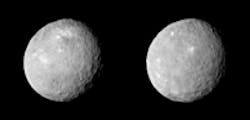Sharpest image yet of dwarf planet Ceres captured by NASA spacecraft
NASA’s Dawn spacecraft has captured new images of the dwarf planet Ceres, which are the sharpest images captured of the planet to date, at 52,000 miles away.
MORE ARTICLES
Vision-guided robot helps make new discoveries under the ice in Antarctica
Image sensors designed by e2v aid in detailed study of comet
Dawn was launched in 2007 to study the asteroid Vesta and dwarf planet Ceres, celestial bodies believed to have formed early in the history of the solar system. Since December 1, 2014, Dawn has been capturing increasingly high-resolution images of Ceres, and on March 6, 2015, the spacecraft is expected to enter into orbit around Ceres. As the images captured by Dawn become clearer, the scientific project team will use these to investigate the nature and composition of the dwarf planet, including the nature of the craters and bright spots that are coming into focus.
The instrument used to capture the images of the planet was Dawn’s Framing Camera, which was designed by Germany’s Max Planck Institute for Solar System Research, to acquire detailed optical images, as well as for navigation. The camera uses 20 mm aperture, f/7.9 refractive optical system with a focal length of 150 mm. It is based on a Thomson TH7888A CCD image sensor, which is a 1024 x 1024 sensor with a 14 µm pixel size that can achieve images at up to 30 fps. It features a 5.5° x 5.5° field of view, and an eight-position filter wheel permits panchromatic and spectrally selective imaging (7 narrow band filters).
Furthermore, the framing camera’s broadest filter allows imaging at wavelengths ranging from 400 to 1050 nm. Its PC is based on a custom radiation-hardened Xilinx system with a LEON2 core and 8 GiB of memory. Because the camera is needed for both science and navigation, the payload has two identical but physically separate cameras (Framing Camera 1 and 2), each with its own optics, electronics, and structure.
"As we slowly approach the stage, our eyes transfixed on Ceres and her planetary dance, we find she has beguiled us but left us none the wiser," said Chris Russell, principal investigator of the Dawn mission, based at UCLA. "We expected to be surprised; we did not expect to be this puzzled."
Dawn previously explored the giant asteroid Vesta for 14 months during 2011 and 2012, allowing the scientists to gain numerous insights about the geological history the asteroid. By comparing Vesta and Ceres, they will develop a better understanding of the formation of the solar system, according to NASA.
View a JPL press release.
Share your vision-related news by contacting James Carroll, Senior Web Editor, Vision Systems Design
To receive news like this in your inbox, click here.
Join our LinkedIn group | Like us on Facebook | Follow us on Twitter | Check us out on Google +
About the Author

James Carroll
Former VSD Editor James Carroll joined the team 2013. Carroll covered machine vision and imaging from numerous angles, including application stories, industry news, market updates, and new products. In addition to writing and editing articles, Carroll managed the Innovators Awards program and webcasts.
